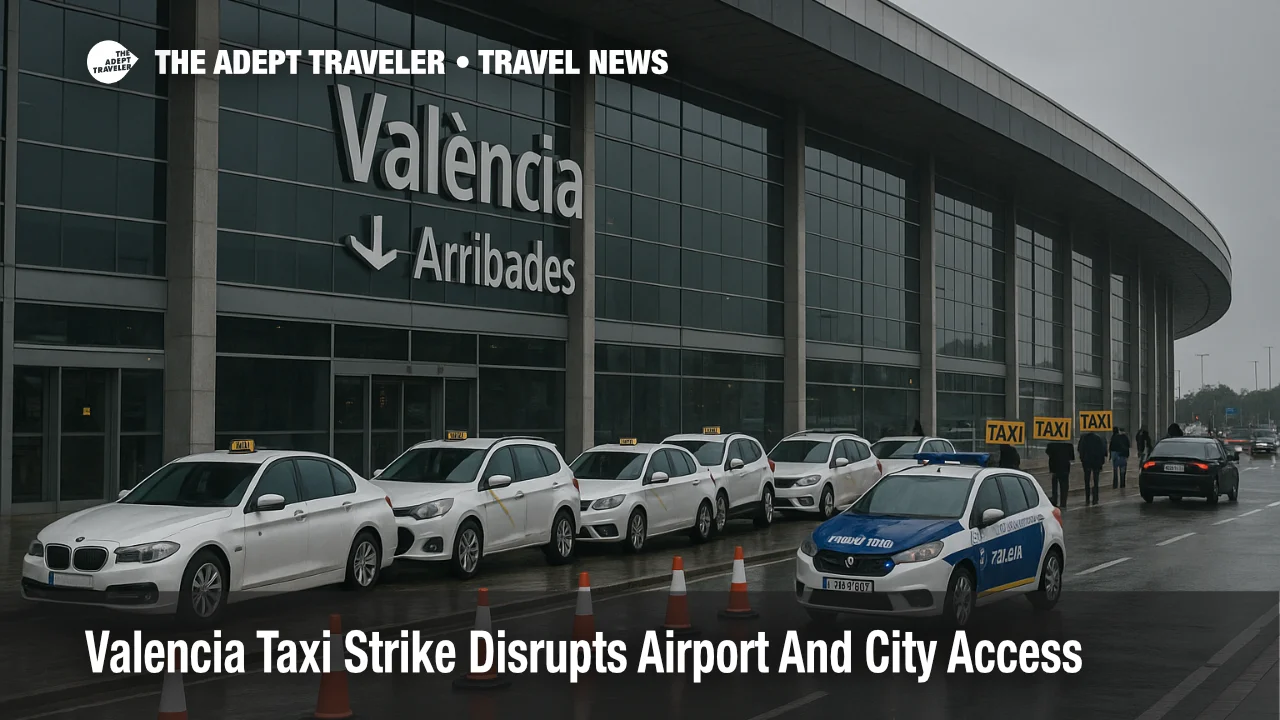Valencia Taxi Strike Disrupts Airport And City Access

Key points
- Taxi unions in Valencia called a four-hour stoppage today to protest VTC competition
- Local police warned of major disruptions on CV-35 and V-21 with diversions into the city
- Expect reduced taxi supply at Valencia Airport and central ranks through early afternoon
- Metrovalencia Line 3 offers 15-minute weekday service to and from the airport
- VTC operators said they plan to run normally during the protest window
Impact
- Airport Access
- Plan 30-45 extra minutes to reach or leave Valencia Airport during and just after the stoppage
- City Center
- Allow additional time near Plaza de España and adjacent corridors where rolling protests pass
- Highway Approaches
- Expect jams and diversions on CV-35 and V-21 into late morning and early afternoon
- Rail Connections
- If connecting at Joaquín Sorolla, favor carry-on and build longer buffers for last-mile delays
- Alternatives
- Pre-book VTC or use Metrovalencia Line 3 when taxi ranks are empty or prepaid transfers fail
Valencia, Spain, faces a four-hour taxi stoppage and rolling vehicle protest this morning, Tuesday, November 4, cutting taxi availability between about 830 a.m. and 1230 p.m. CET and constraining key approaches into the city. Local police flagged significant traffic impacts and diversions on the CV-35 and V-21, with knock-on congestion expected to linger until roughly 2:00 p.m. CET. The action targets what unions describe as ride-hail intrusion by vehicles de transporte con conductor (VTC), while VTC operators say they will maintain normal service. Flyers, cruise-coach transfers, and rail connectors should pre-book alternatives, allow extra time, or pivot to Metrovalencia Line 3 for airport access.
Protest route and where delays cluster
Taxi associations called a general service stoppage paired with marches through central Valencia and concentrations at civic buildings. Police advisories indicate two taxi columns converging toward Plaza de España and adjacent arteries, with heavy effects on inbound traffic from the north and west via the V-21 and CV-35 and on urban corridors such as Pío XII, Fernando el Católico, and Ramón y Cajal. Practically, that means slower buses and coaches, intermittent lane closures, and temporary diversions that ripple into late morning even after vehicles disperse. Travelers should avoid time-sensitive car trips along these corridors during the core window and for approximately 60-90 minutes afterward.
Airport forecourt and last-mile access
Expect taxi ranks at Valencia Airport to thin out or stand empty during the stoppage, with longer waits for any remaining licensed cabs. VTC pickup lanes may be busier than usual, and curbside congestion can increase as private cars, coaches, and pre-booked hires absorb demand. If you have a prepaid taxi transfer that fails to appear within a reasonable grace period, switch to a VTC or coach option if available, or move to the Metrovalencia entrance in the terminal and take Line 3 toward the city. Build extra time on arrivals for bag claim and ground transport, and reconsider tight self-connects.
Metro frequencies and how to ride Line 3
For an airport-to-city fallback during taxi shortages, Metrovalencia Line 3 runs on a published weekday headway of about 15 minutes, with service spanning the airport and key transfer stations toward the center. Travel time to the city varies by destination and transfers, but the predictable headway often beats waiting for scarce taxis during a stoppage. Buy tickets at station machines, keep your validated ticket handy for exit gates, and allow extra margin if you still need a short last-mile ride at your destination.
Rail connections at Joaquín Sorolla
If you are connecting to AVE or long-distance Renfe services at Estación Joaquín Sorolla, plan longer buffers. The station sits within the urban grid likely to feel protest spillover, particularly around Plaza de España. Favor carry-on to move faster through crowds and diversions, know your platform and booking code in advance, and consider Metrovalencia segments for part of the last mile if surface traffic stalls.
Why the strike and what VTCs say
Taxi unions frame the protest as a response to alleged lax enforcement and "intrusion" by VTCs, pressing the regional transport department for inspections and limits on urban VTC activity. VTC trade groups counter that they will operate normally and call for dialogue. For travelers, the practical takeaway is that VTC availability may be higher than taxis during the action, but demand spikes could extend wait times and surge pricing. Book early, confirm driver and pickup zone, and have a Metrovalencia backup.
Background
Taxi stoppages in Valencia have recurred in recent years around fare policy, inspection resources, and the balance between traditional taxis and VTCs. Today's action differs by concentrating impacts into a short morning window tied to inbound commuting and airport peaks, magnifying delays on the V-21 and CV-35 funnels and around Plaza de España before easing into early afternoon. Police social posts ahead of the event emphasized citywide effects and urged drivers to avoid the most affected approaches or switch to transit where possible.
Final thoughts
The Valencia taxi strike is short, but the timing and rolling format mean outsized disruption for morning flyers and downtown trips. If you must travel today, pre-book a VTC, shift to Metrovalencia Line 3, and pad your schedule through 2:00 p.m. CET. Reconfirm any prepaid taxi transfers and have a plan B.
Sources
- Manifestación de taxis en Valencia el martes 4 de noviembre
- Se prevé una jornada de grandes atascos, dos columnas hacia Plaza de España
- Huelga masiva del taxi en la Comunitat Valenciana, horario 830-1230
- VTCs garantizan transporte durante las movilizaciones
- Metro al Aeropuerto: frecuencias y acceso AENA Valencia
- Consulta de horarios y planificador, Metrovalencia
- Policia Local València, aviso de doble manifestación 800-1400
